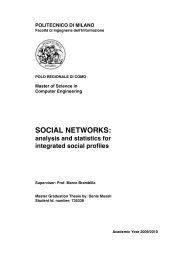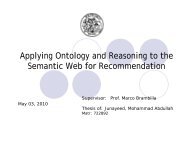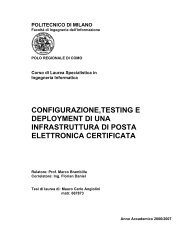Una metodologia di analisi e confronto per strumenti BPM
Una metodologia di analisi e confronto per strumenti BPM
Una metodologia di analisi e confronto per strumenti BPM
You also want an ePaper? Increase the reach of your titles
YUMPU automatically turns print PDFs into web optimized ePapers that Google loves.
22 Capitolo 2. Stato dell’Arte<br />
• un in<strong>di</strong>catore <strong>di</strong> una con<strong>di</strong>zione, ad esempio la presenza <strong>di</strong> un token<br />
può in<strong>di</strong>care il raggiungimento <strong>di</strong> una con<strong>di</strong>zione<br />
Un posto può assumere il ruolo <strong>di</strong>:<br />
• un tipo <strong>di</strong> mezzo <strong>di</strong> comunicazione, ad esempio una linea telefonica;<br />
• un buffer, ad esempio una coda;<br />
• una locazione geografica, ad esempio un luogo specifico dell’organizzazione;<br />
• un possibile stato o con<strong>di</strong>zione, ad esempio un possibile stato in cui si<br />
trova un ascensore;<br />
<strong>Una</strong> transizione può assumere il ruolo <strong>di</strong>:<br />
• un evento, ad esempio l’inizio <strong>di</strong> un’o<strong>per</strong>azione;<br />
• una trasformazione <strong>di</strong> un oggetto, ad esempio l’aggiornamento <strong>di</strong> un<br />
database;<br />
• il trasporto <strong>di</strong> un oggetto, ad esempio l’invio <strong>di</strong> un file;<br />
Per quanto riguarda l’instradamento del flusso <strong>di</strong> processo (routing), le reti<br />
<strong>di</strong> Petri <strong>per</strong>mettono <strong>di</strong> definire quattro tipologie riguardanti i workflow:<br />
1. Sequenze <strong>di</strong> task.<br />
2. Instradamento parallelo, caratterizzato da un componente <strong>di</strong> tipo ANDsplit<br />
all’inizio e <strong>di</strong> tipo AND-join al termine.<br />
3. Instradamento selettivo, caratterizzato da un componente <strong>di</strong> tipo ANDsplit<br />
all’inizio e <strong>di</strong> tipo AND-join al termine.<br />
4. Instradamento iterativo, che può essere <strong>di</strong> tipo repeat-until o <strong>di</strong> tipo<br />
while-do.<br />
Un processo viene definito come un collezione <strong>di</strong> task, con<strong>di</strong>zioni, sottoprocessi<br />
e relazioni. L’attivazione delle varie transizioni lungo il processo<br />
avviene me<strong>di</strong>ante l’utilizzo <strong>di</strong> <strong>di</strong>versi trigger (figura 2.2.2) che sono stati<br />
definiti appositamente <strong>per</strong> il contesto dei processi <strong>di</strong> workflow:<br />
• Automatici (Automatic): il task viene attivato automanticamente non<br />
appena viene abilitato a farlo. Questo trigger viene utilizzato quando<br />
i task sono gestiti <strong>di</strong>rettamente dal sistema e non richiedono alcun<br />
intervento umano.



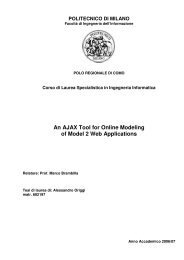
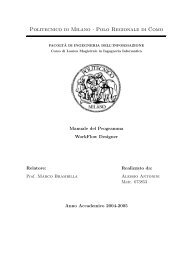
![Full text preview of the chapter [PDF] - Politecnico di Milano](https://img.yumpu.com/44021924/1/180x260/full-text-preview-of-the-chapter-pdf-politecnico-di-milano.jpg?quality=85)
